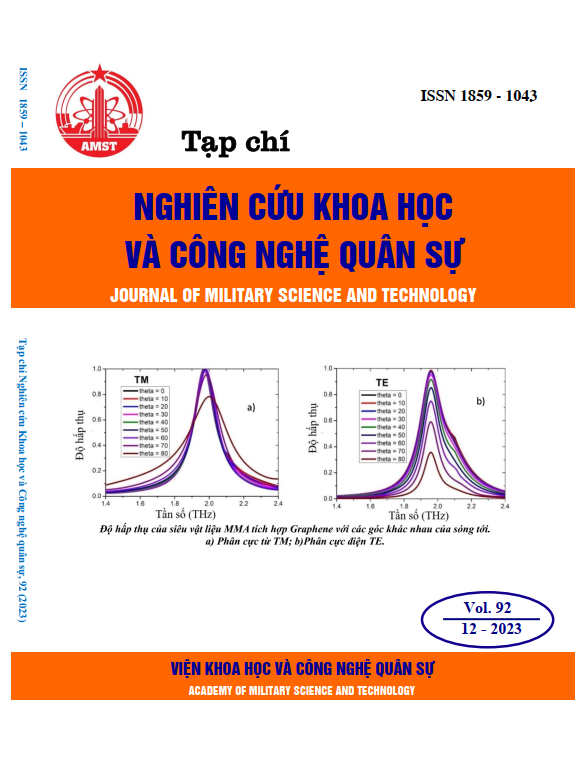Effect of different aging conditions on the mechanical and corrosion properties of 7075 aluminum alloy
542 viewsDOI:
https://doi.org/10.54939/1859-1043.j.mst.92.2023.86-91Keywords:
7075 alloy; B95 alloy; Aging; Mechanical properties; Sea corrosion.Abstract
In this paper, the effects of some aging treatments on the characteristic properties of the high strength-deformation 7075 aluminum alloy plate are studied. Some heat treatments such as natural aging, traditional aging T6, over-aging T76, re-aging RRA and interrupted aging T6I6 are studied. The 7075 alloy system, after aging, is evaluated for characteristic properties: mechanical properties, salt spray corrosion, and electrochemical corrosion. The high strength-deformation 7075 aluminum alloy plate, after different aging, has various mechanical and chemical properties depending on usage requirements, select process concordant: T6I6 can increase the ultimate strength, tensile strength up to 630 MPa, hardness 91 HRB; T76 can increase ability corrosion resistance optimal in seawater environment; RRA ensure simultaneously mechanical properties and ability corrosion resistance good.
References
[1]. G. E. Totten, D. Scott MacKenzie, “Handbook of Aluminum: Volume 1 Physical Metallugy and Processes”, Marcel Dekker, Inc. 270 Madison Avenue, New York, NY 10016, (2003).
[2]. A. Azarniya, A. K. Taheri and K. K. Taheri, “Recent advances in ageing of 7xxx series aluminum alloys: A physical metallurgy perspective”, J Alloys Compd, Vol. 781, pp. 945 – 983, (2019). DOI: https://doi.org/10.1016/j.jallcom.2018.11.286
[3]. Y. Wang, L. Cao, X. Wu, X. Tong, B. Liao, G. Huang, Z. Wang, “Effect of retrogression treatments on microstructure, hardness and corrosion behaviors of aluminum alloy 7085”, J Alloys Comp, 814, 152264, (2020). DOI: https://doi.org/10.1016/j.jallcom.2019.152264
[4]. X. Peng, Y. Li, G. Xu, J. Huang and Z. Yin, “Effect of Precipitate State on Mechanical Properties, Corrosion Behavior, and Microstructures of Al-Zn-Mg-Cu Alloy”, Met Mater Int, Vol. 24, pp. 1046 - 1057, (2018). DOI: https://doi.org/10.1007/s12540-018-0057-z
[5]. X. Chen, S. Zhai, D. Gao, Y. Liu, J. Xu and Y. Liu, “Enhanced stress corrosion cracking resistance and electrical conductivity of a T761 treated Al-Zn-Mg-Cu alloy thin plate”, Mater Res Express, Vol. 5, pp. 1 – 18, (2018). DOI: https://doi.org/10.1088/2053-1591/aaa605
[6]. A. D. Isadare, B. Aremo, M. O. Adeoye, O. J. Olawale, M. D. Shittu, “Effect of Heat Treatment on Some Mechanical Properties of 7075 Aluminium Alloy”, Mat. Res 16(1), pp. 190-194, (2013). DOI: https://doi.org/10.1590/S1516-14392012005000167
[7]. R. Su, T. Liu, Y. Qu, G. Bai, R. Li, “Mechanical Properties and Corrosion Behavior of Spray-Formed 7075 Alloy with One-Stage Aging”, Jou. Mat. Eng. Per, (2019).
[8]. TCVN 7699-2-52:2007 “Thử nghiệm môi trường - Phần 2-52: Các thử nghiệm - Thử nghiệm Kb: Sương muối, chu kỳ (dung dịch natri clorua)”, (2007).
[9]. Trịnh Xuân Sén, “Ăn mòn và Bảo vệ kim loại”, Nhà xuất bản Đại học Quốc gia Hà Nội, tr. 153, (2006).







